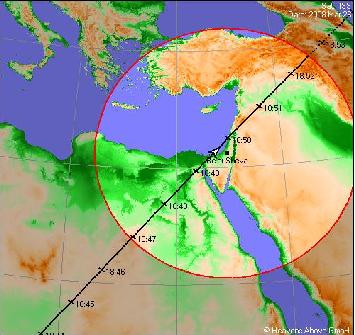Today's passage is expected to be double or triple - the shuttle, the supply spacecraft Jules Verne and possibly the shuttle Endeavour. The best observation is in the evening when we are in the dark but the satellites are still illuminated by the sunlight

The heavens-above website is a great tool for astronomy and space enthusiasts and through it (with the hope of some good weather) this week we will be able to watch a number of impressive transits of the International Space Station, the Space Shuttle Andover and also the "Jules Warren" the new space probe of the European Space Agency .
Today - 26/3 it will be possible to see at 18:42 the supply spacecraft Jules Warren moving from southwest to northeast. Four minutes later we will see the International Space Station following it, and in a short time the space shuttle Endeavor will also be seen on the same track (although this figure is still uncertain because the shuttle is scheduled to land that night, and it is possible that a few hours before its landing it will already change course. The brightness of the space station in transit It will be minus 2.
Passages of the space station are also expected on Thursday and Friday, this time from west to east. On Thursday 27/3 the transition will take place at 19:10 and the brightness of the station will be 0, and on Friday, at 18:19 minutes and its brightness will be 0.4.
The reason for being able to see the International Space Station precisely in the hours after sunset is because an hour and a half after sunset the surface of the Earth has already darkened, but the space station, the shuttle, the Hubble Space Telescope and several other satellites are still in the sunlight, for this reason we can look up and see them as points of light Moving in the evening sky. The International Space Station, a joint project of space probes from several countries, primarily the USA and Russia, is the most prominent and its brightness is sometimes greater than that of Venus or Jupiter. The space station is so bright because of its solar panels, their vast area reflects much of the sunlight back to Earth and we see a moving point of light in space.
The same spacecrafts that can be seen are in an orbit called LEO (low earth orbit), a relatively low orbit around the earth at a height of about 200-600 km above the surface. Their speed is about 8 km per second. This speed is so high that a centrifugal force is created that opposes the Earth's gravity. The speed of their movement is such that a complete circle around the earth takes only an hour and a half! Sometimes you can see two consecutive passes of the space station, the Hubble or the shuttle in the same evening. The direction of movement of those spacecraft will usually be from west to east - against the direction of the earth's movement, the duration of each passage is about 5 minutes.
Besides well-known and "famous" spacecraft such as the International Space Station, the Space Shuttle and the Hubble Space Telescope (educational posters about these spacecraft can be obtained at the Astronomy Center at Beit Tazif), this week we will also be able to notice the Jules Warne spacecraft named after the famous French science fiction writer. On April 3, after many tests and various maneuver attempts, the spacecraft will dock at the International Space Station and will be used by the European Space Agency to send various cargoes to the space station and even as a room that will be added to the space station. Jules Warren can be seen when she is slightly (about 2,000 km) ahead of the space station. After the Endeavor detaches from the space station, we will be able to see it chasing the space station. In order to observe spacecraft passages, you must go to a place that is not lit, although most of the space station passages are very bright and can be seen even in lit places. According to the information provided on the heavens-above website and summarized in the table, you must look in the direction in which the spacecraft or satellite will appear. It is recommended to leave a few minutes earlier and sometimes you have to wait a few more minutes for the spaceships to appear. Of course, clouds or heavy haze may interfere or prevent us from seeing the spacecraft passages. All times and directions in Talblaot are shown according to winter time in Israel to a viewer located in Be'er Sheva.
Additional astronomical information is available
On the website of the Ilan Ramon Center for Youth Seeking Physics
More details about satellite crossings can be found on the website "Heaven Above"

3 תגובות
To Arie, I actually watched Tel Aviv. Indeed there were clouds, but the objects could be seen even among the clouds.
There were clouds in Tel Aviv. We couldn't see. Last time Amir gave us a reminder we saw the space station with fun.
I just came back from watching!! It was nice 😛